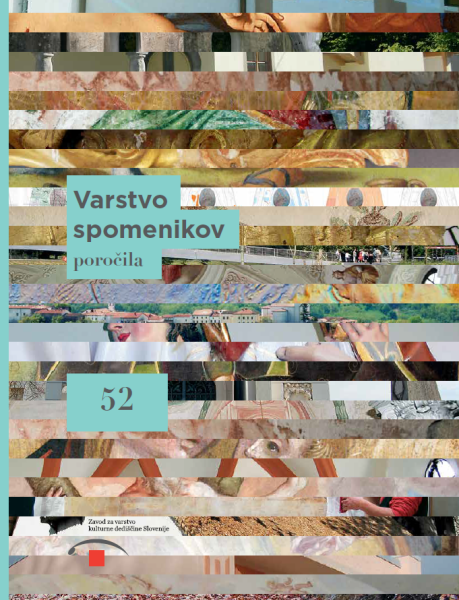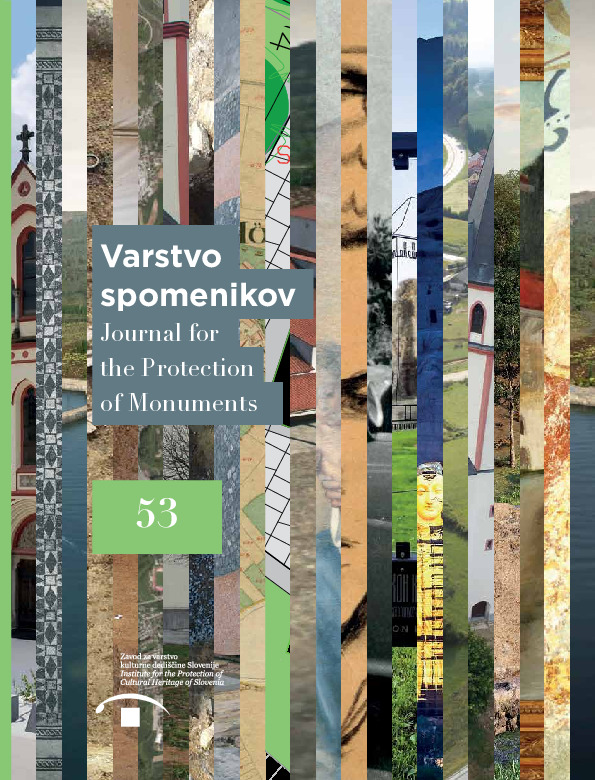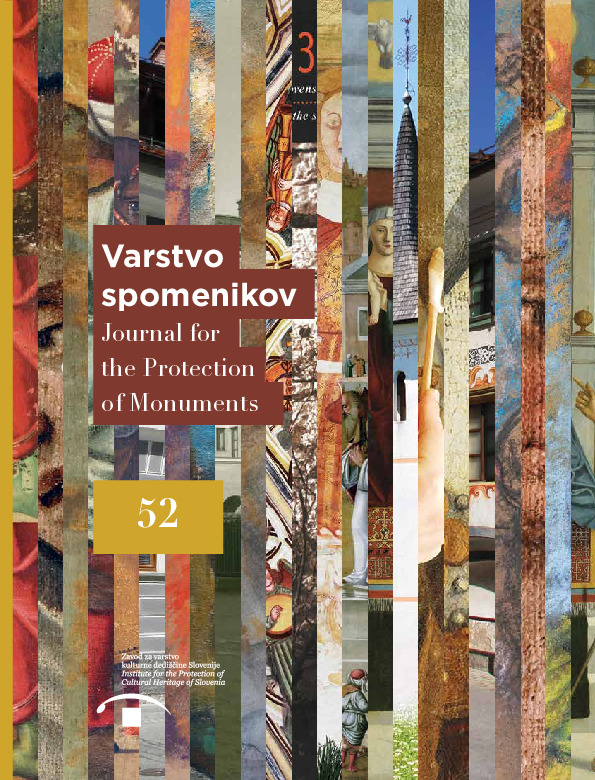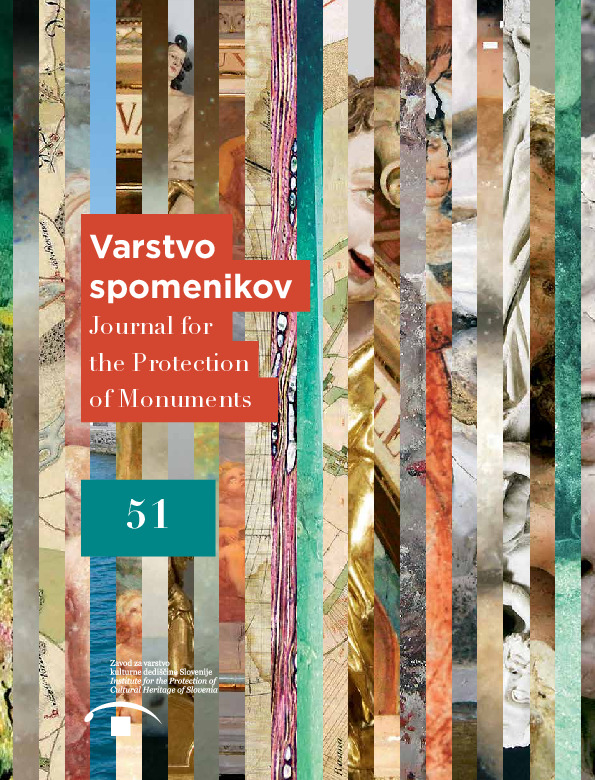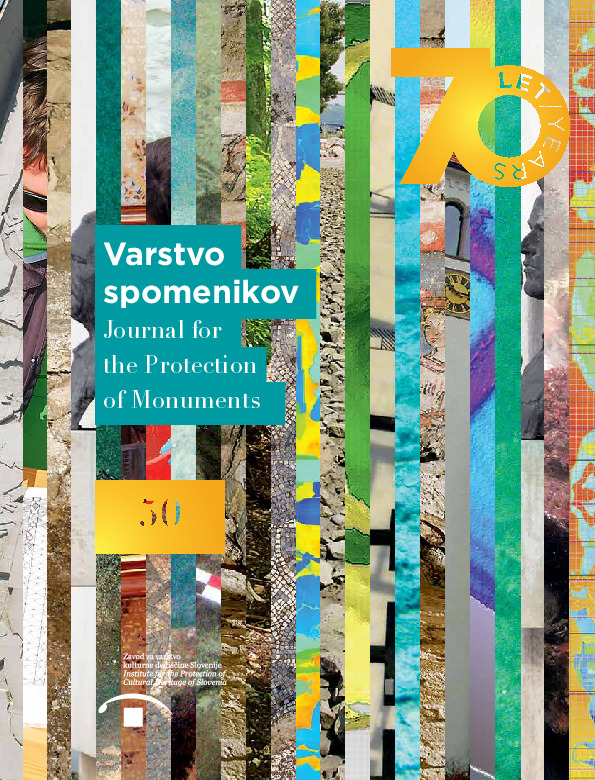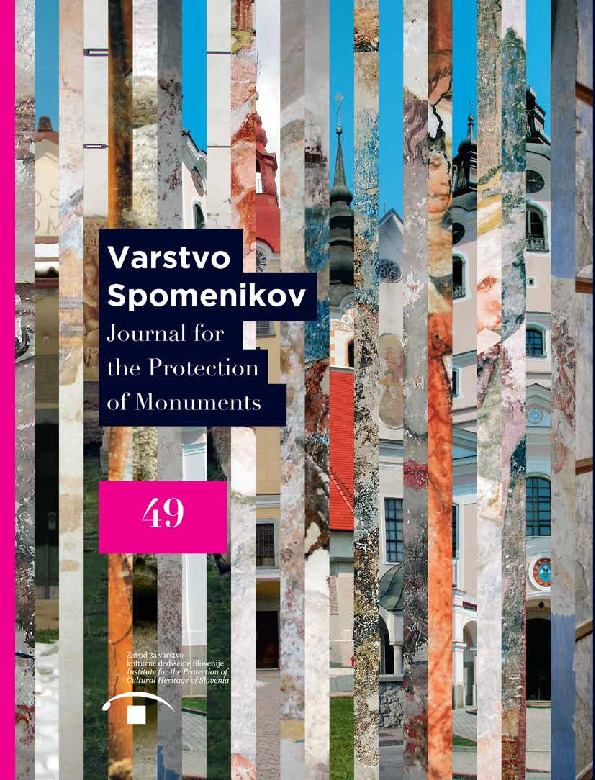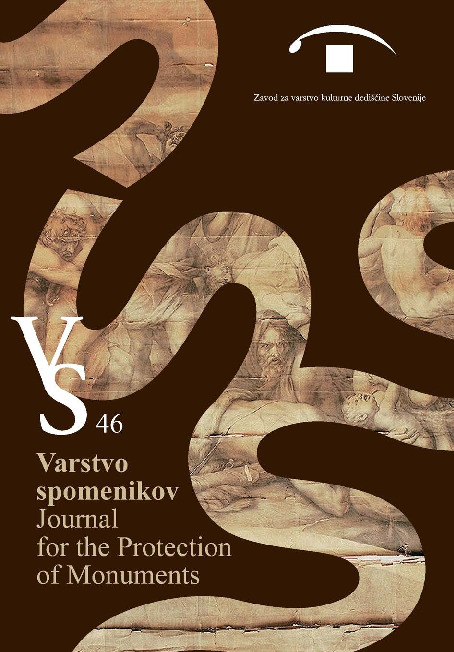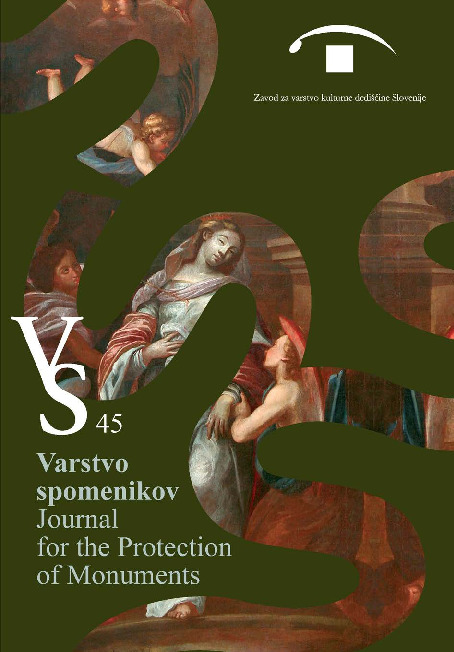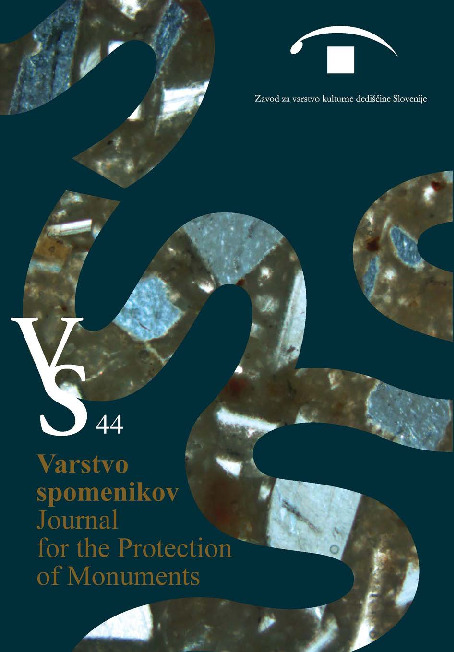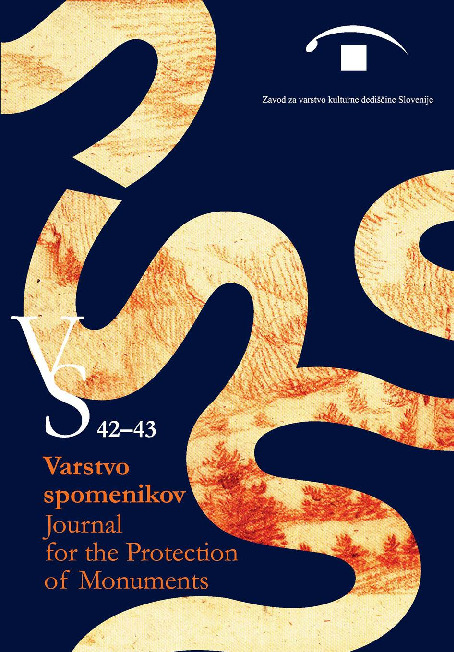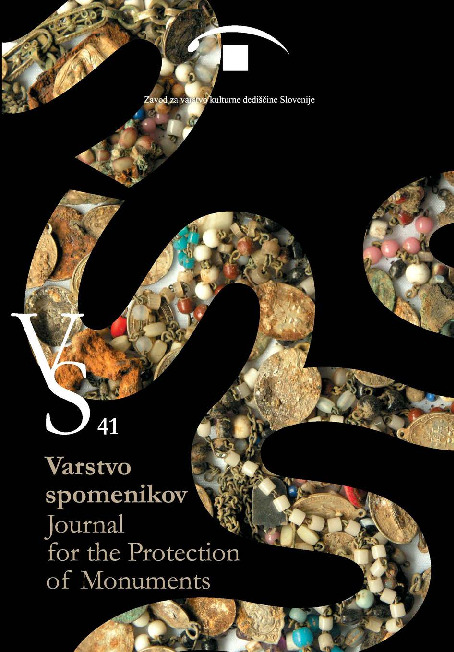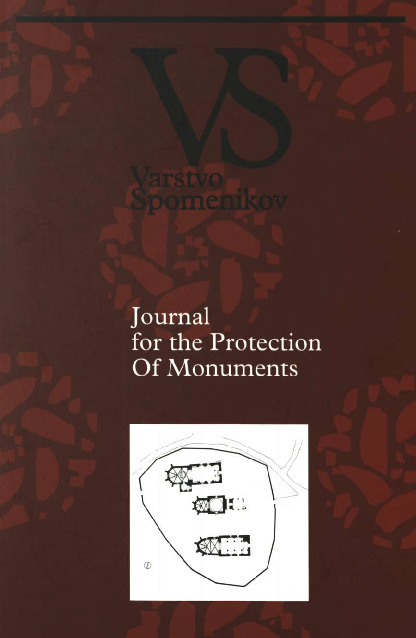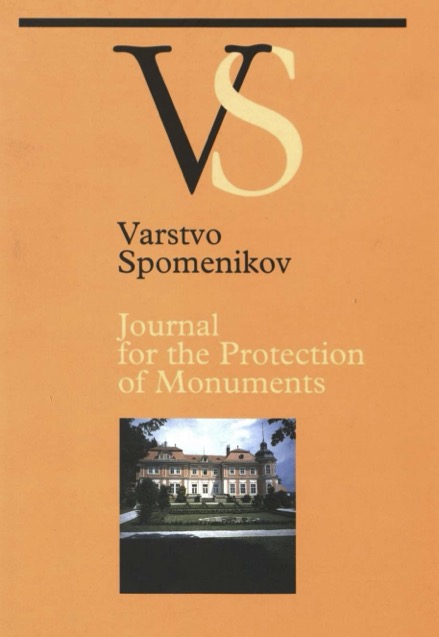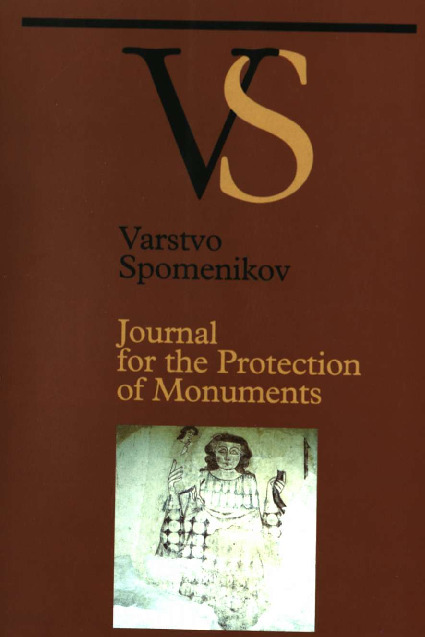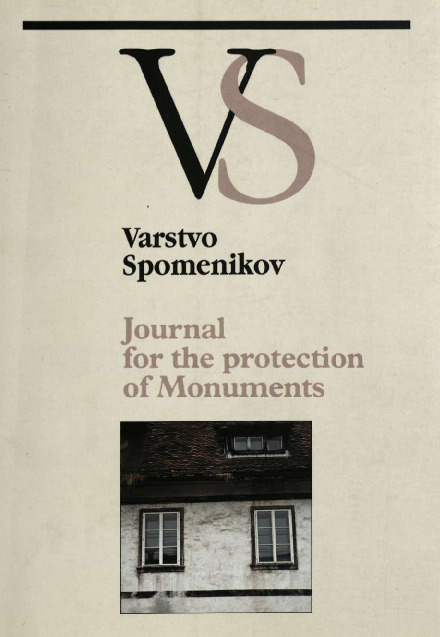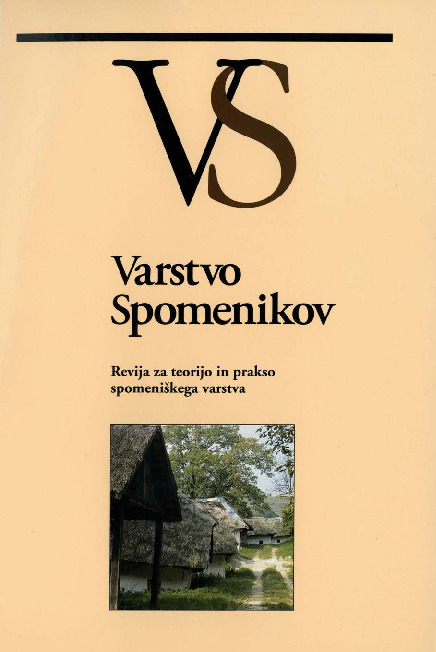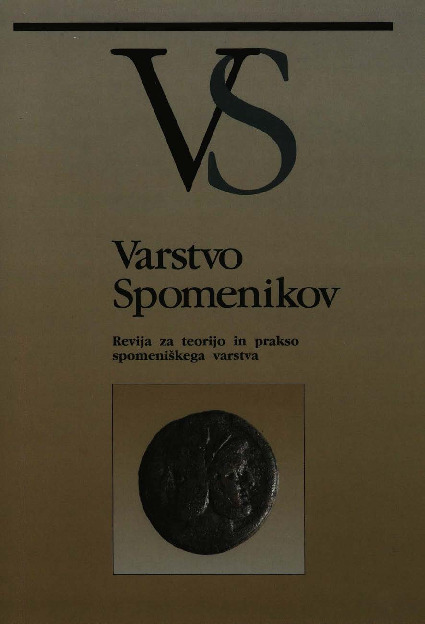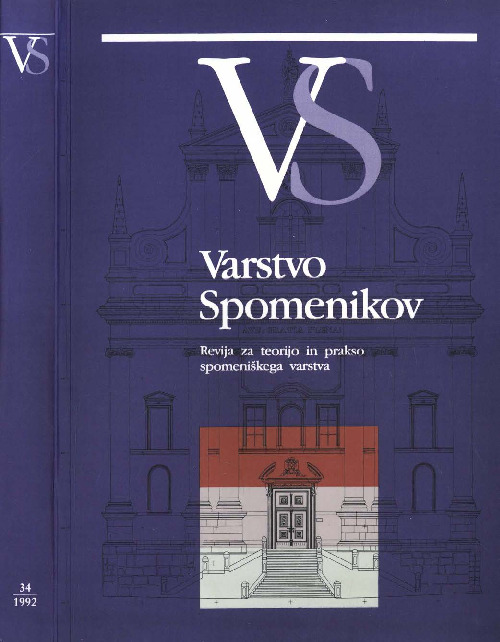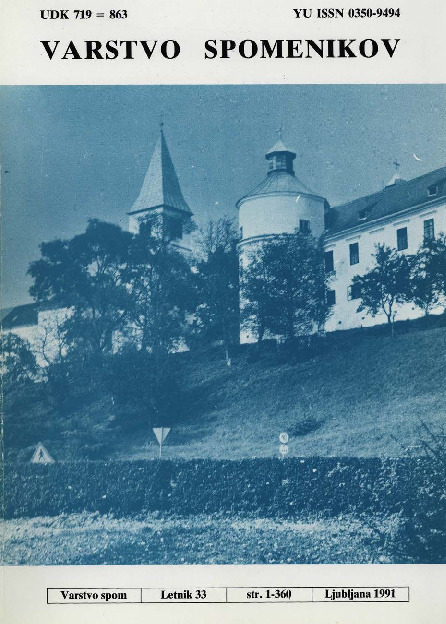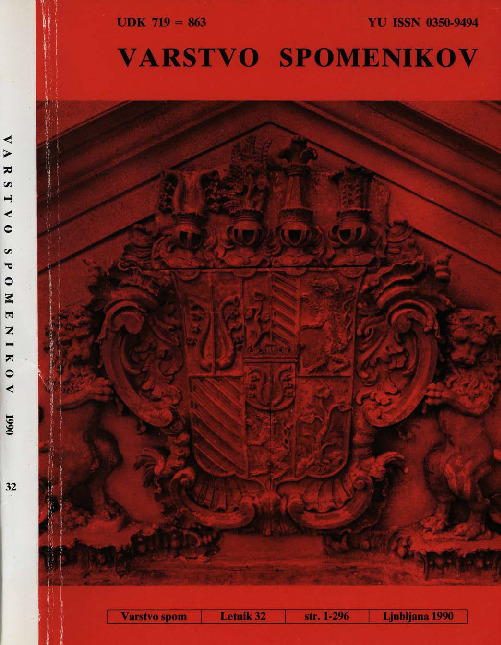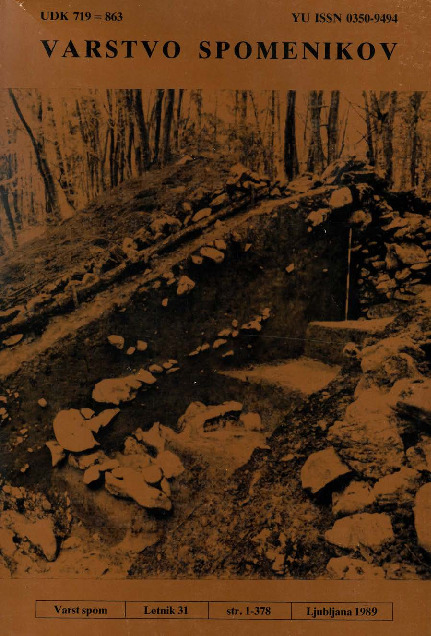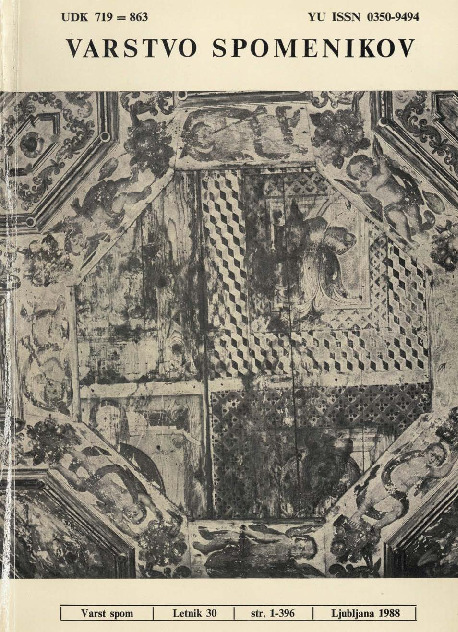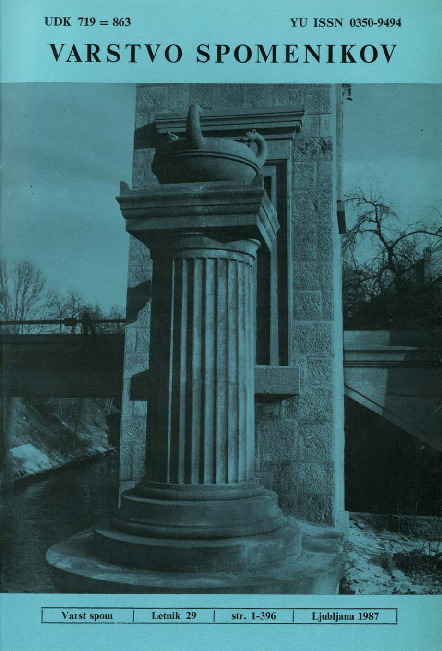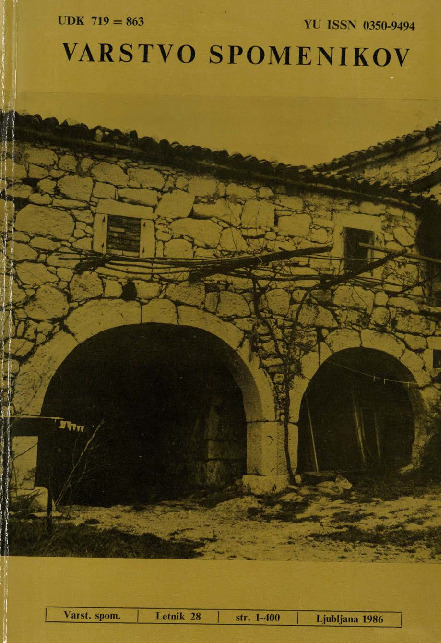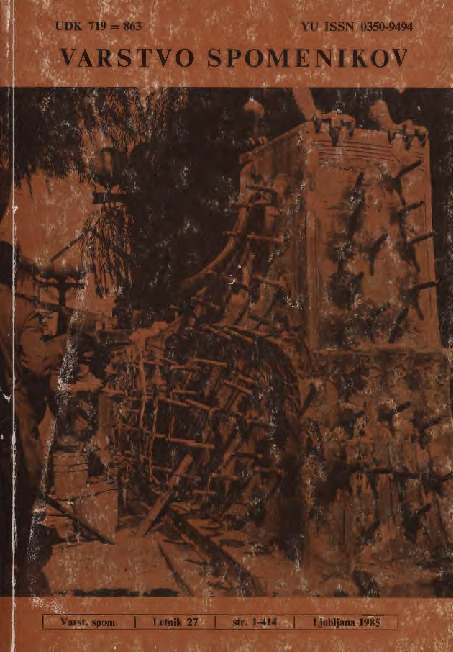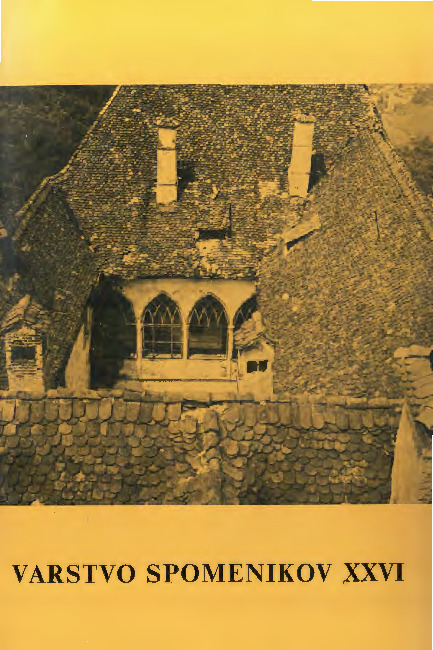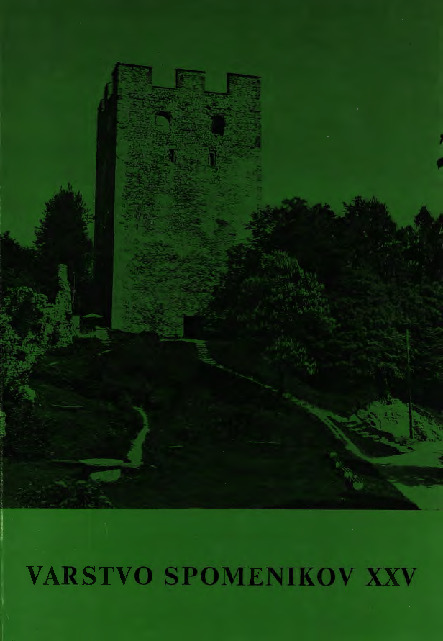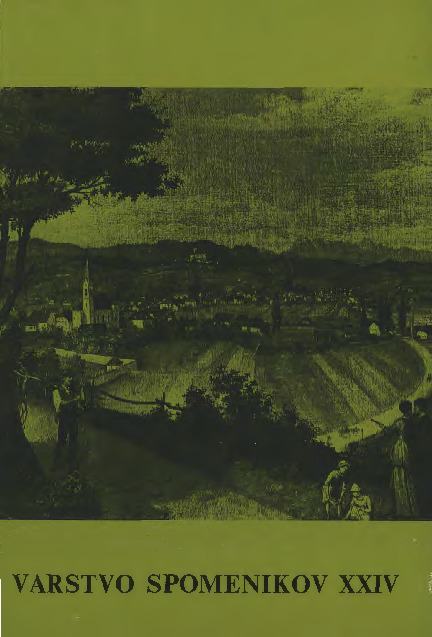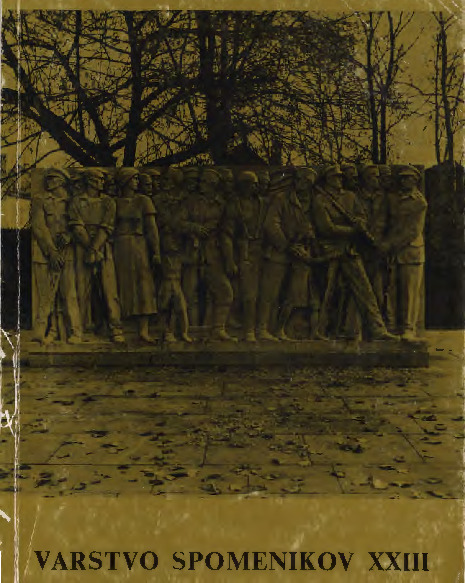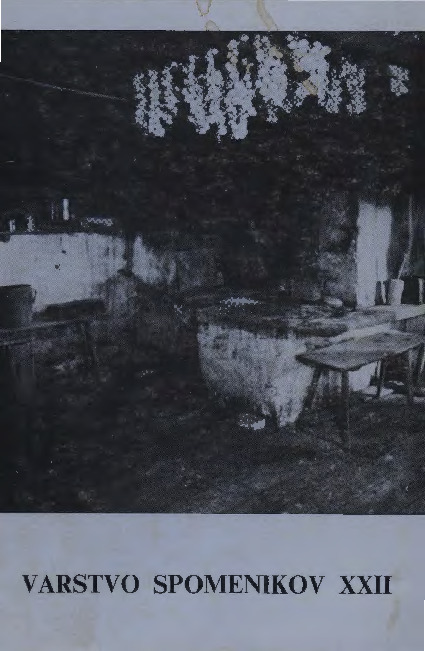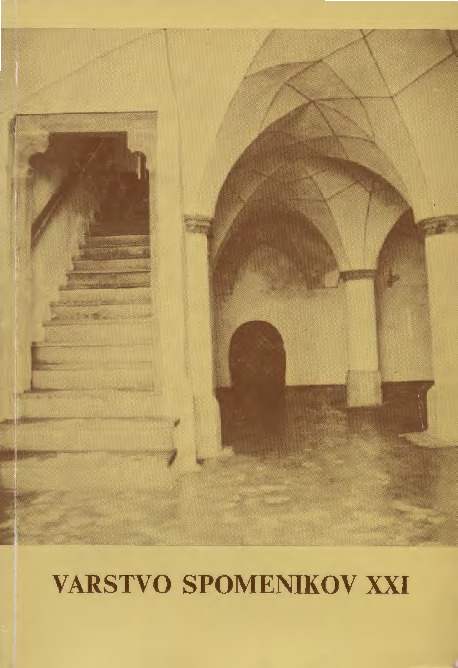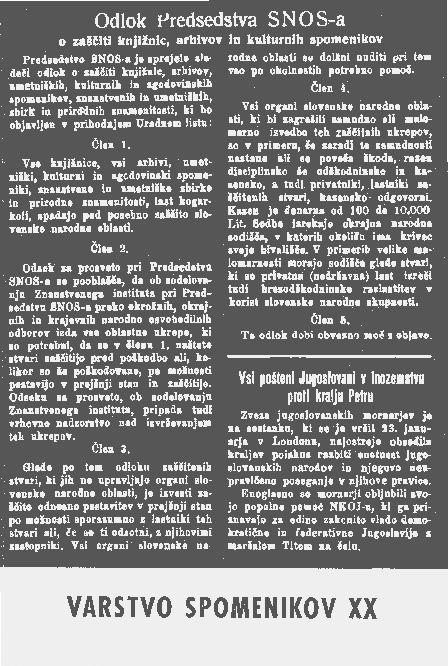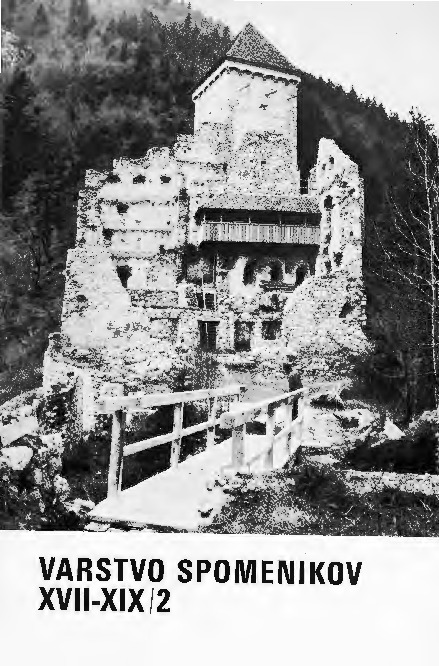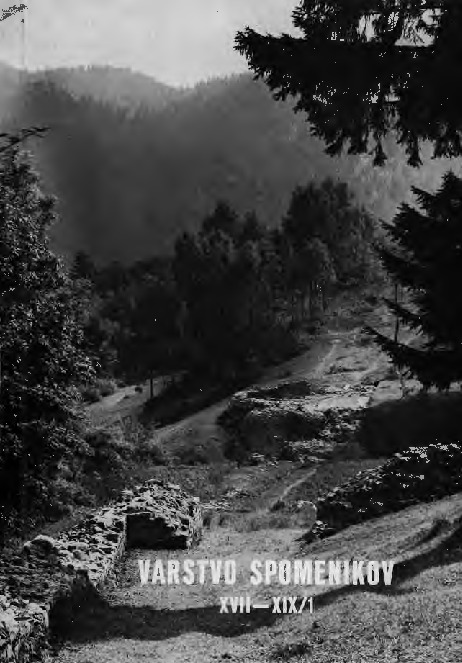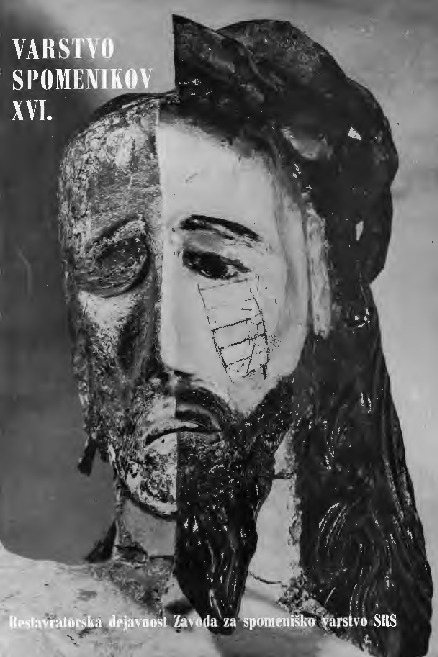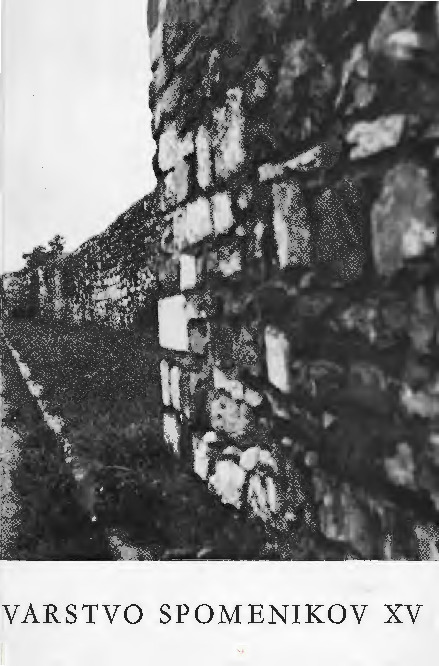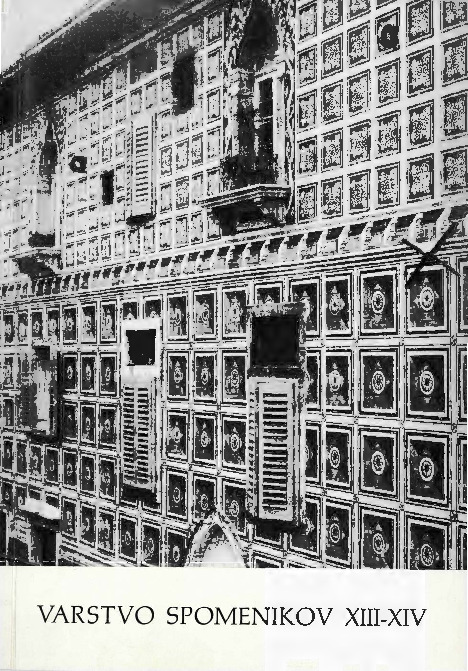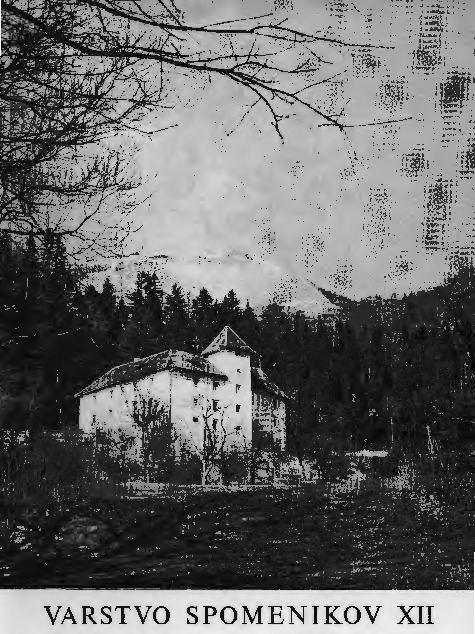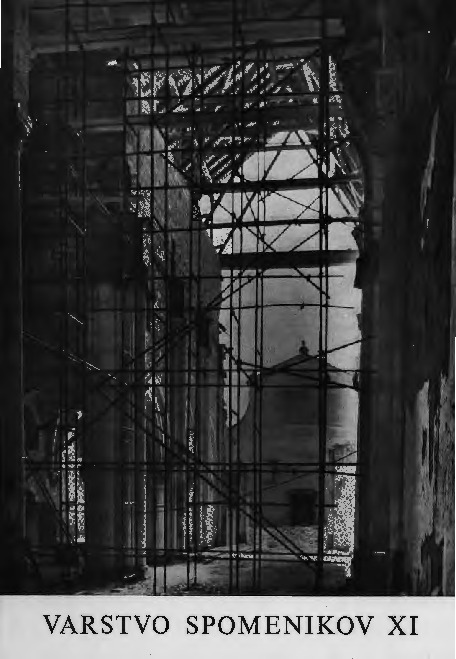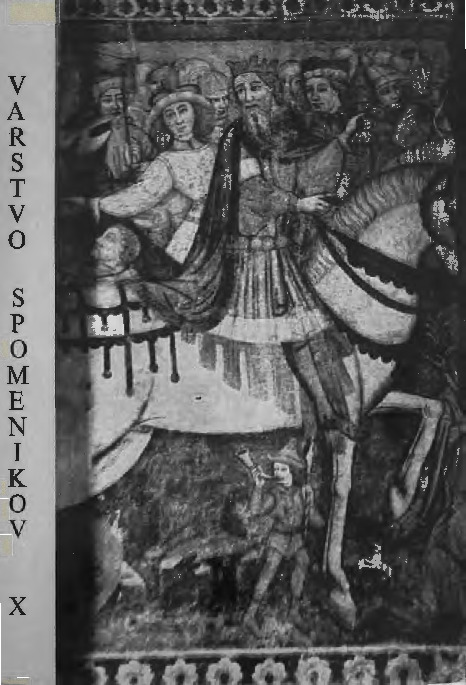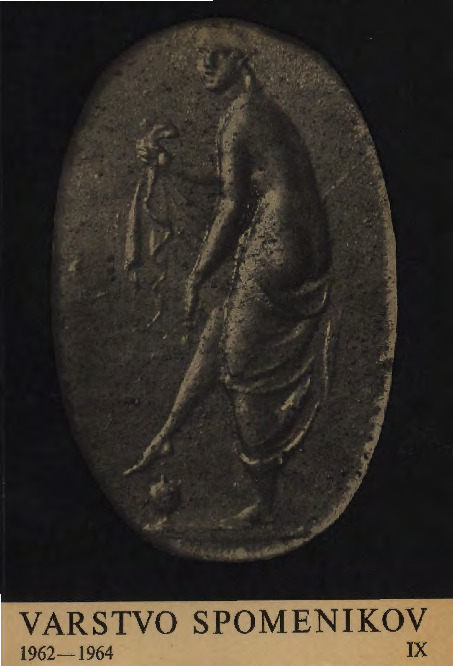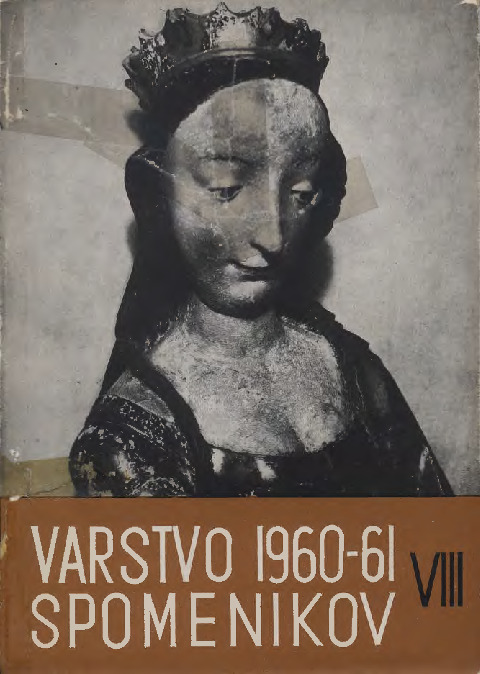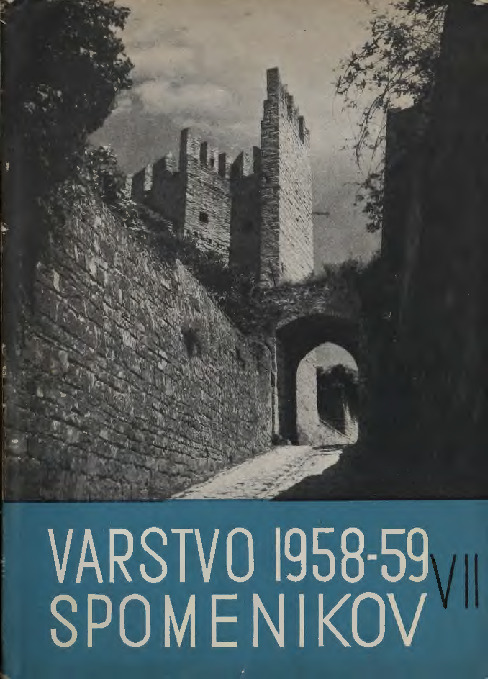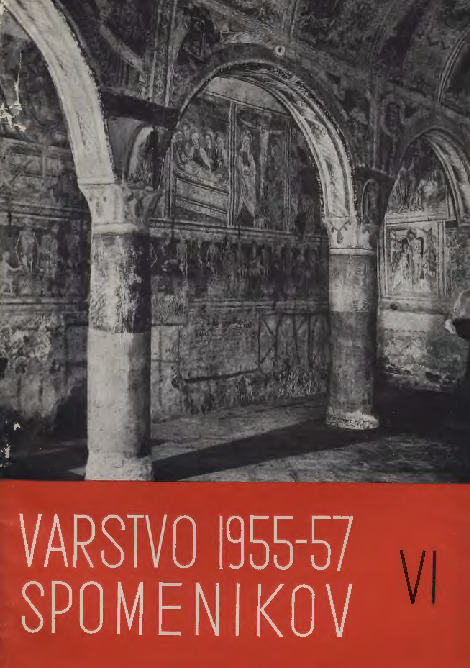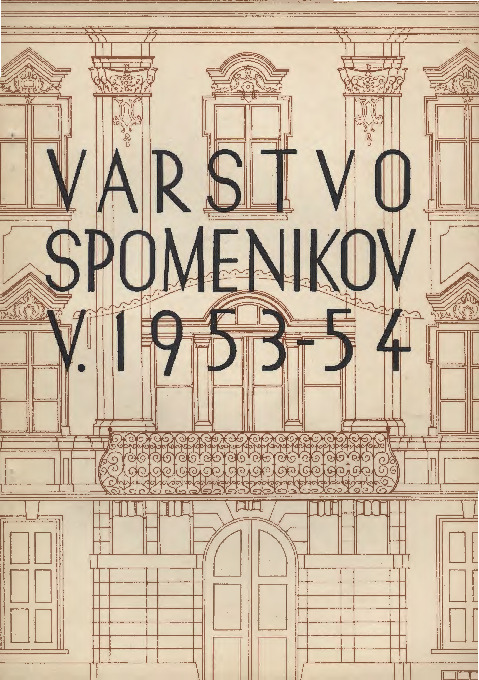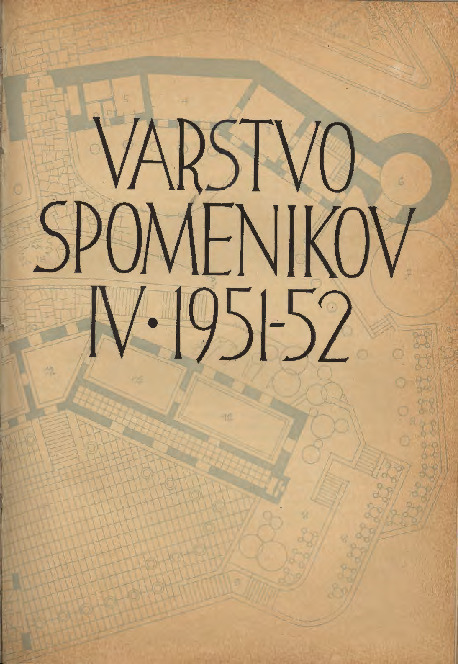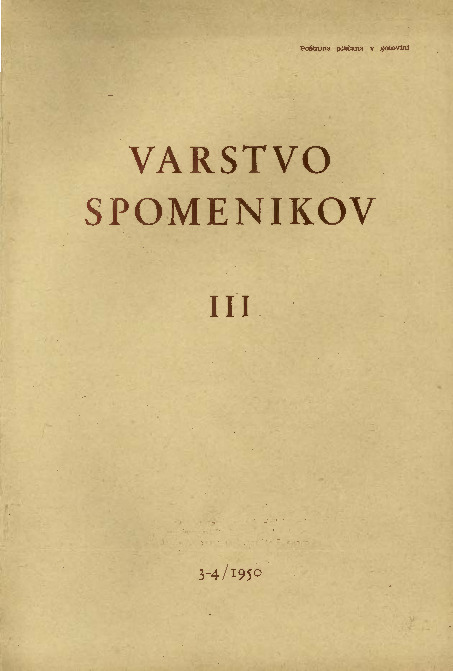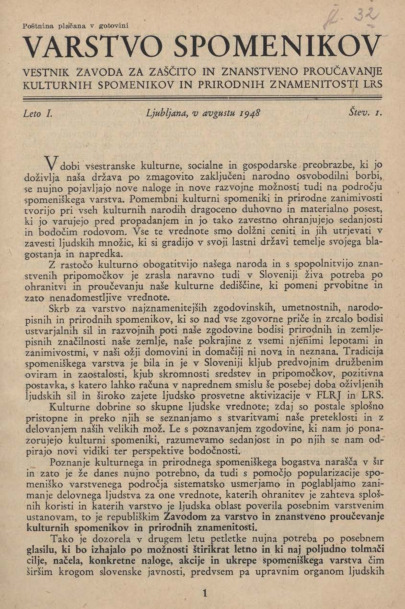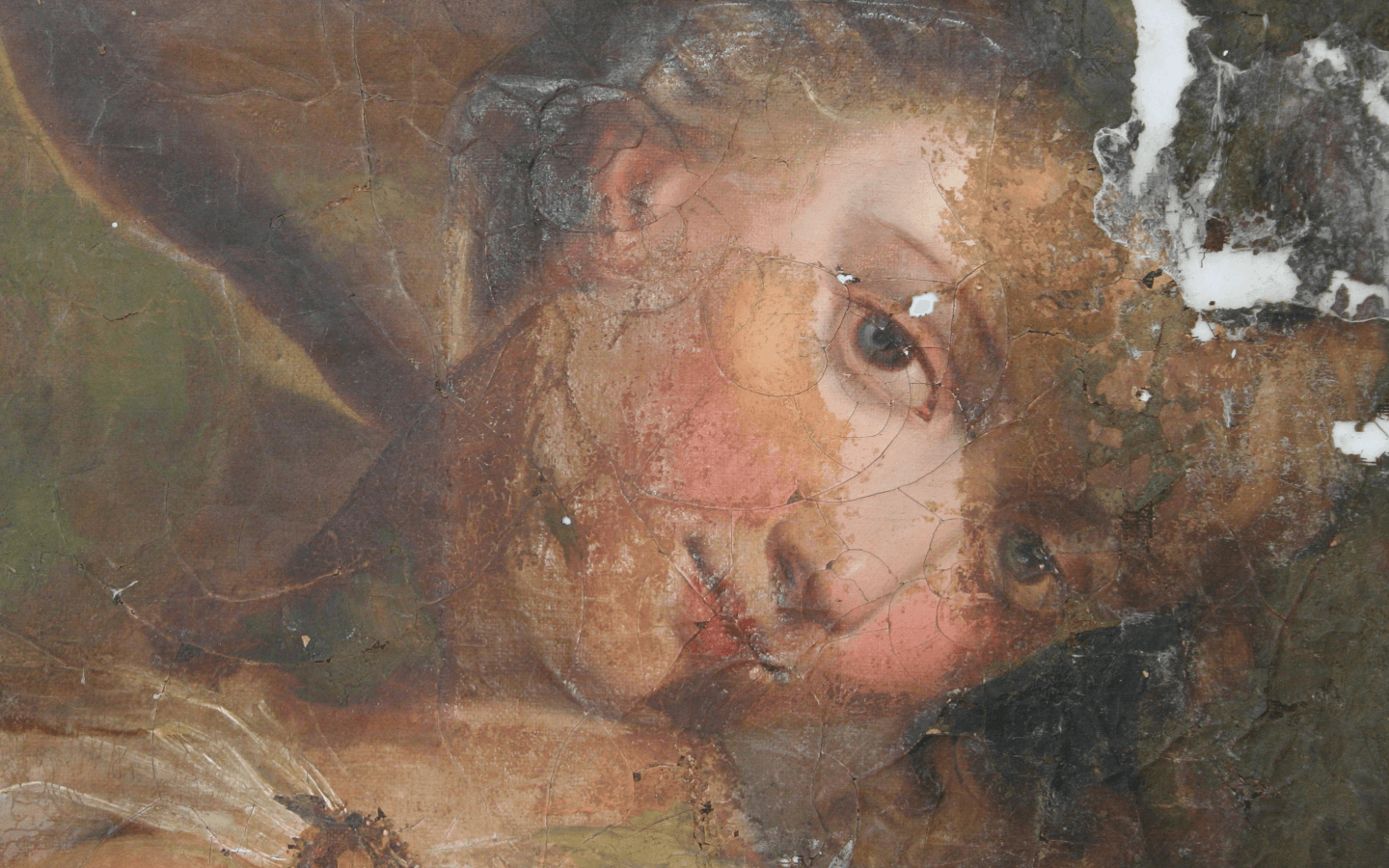
Protection of monuments
The journal Protection of Monuments is a periodical scientific and professional publication of the Institute for the Protection of Cultural Heritage of Slovenia. The journal has been published since 1946.
Monument Protection is dedicated to the dissemination of scientific and professional knowledge and understanding on the protection and conservation of immovable cultural heritage.
The issues are generally not thematic. The journal publishes contributions from various scientific disciplines (archaeology, ethnology, art history, architecture, landscape architecture, conservation, restoration, etc.), following the scientific and professional interest of the authors in the protection, research and management of cultural heritage, international instruments and national legislation, spatial planning and informatics in the field of monument protection, conservation studies, the history and doctrine of monument protection, etc.
Editorial Board
Institute for the Protection of Cultural Heritage of Slovenia
Monument Protection - Editorial
Poljanska cesta 40
SI-1000 Ljubljana
Editor: Biserka Ribnikar Vasle, biserka.ribnikar@zvkds.si
Editorial Board
- Dr. Andrej Gaspari, University of Ljubljana, Faculty of Arts, Department of Archaeology, Ljubljana, Slovenia
- Dr. Sonja Ifko, University of Ljubljana, Faculty of Architecture, Ljubljana, Slovenia
- Dr. Mojca Marjana Kovač, Institute for the Protection of Cultural Heritage of Slovenia, Piran, Slovenia
- Dr. Robert Peskar, Institute for the Protection of Cultural Heritage of Slovenia, Ljubljana, Slovenia
- Dr. Bojana Rogelj Škafar, Slovenian Ethnographic Museum, Ljubljana, Slovenia
- Mag. Marko Stokin, Institute for the Protection of Cultural Heritage of Slovenia, Ljubljana, Slovenia
- Dr. Marko Špikić, Faculty of Arts, Sveučilište u Zagreb, Department for the Study of Art, Zagreb, Croatia
- Mag. Tamara Trček Pečak, University of Ljubljana, Academy of Fine Arts and Design, Ljubljana, Slovenia
- Dr. Katharina Zanier, Institute for the Protection of Cultural Heritage of Slovenia, Ljubljana, Slovenia
- Mag. Gorazd Živković. Bundesdenkmalamt, Abteilung für Kärtnen, Klagenfurt, Austria
Introducing
1. Monument Protection is the main Slovenian scientific journal for the theory and practice of monument protection. It is published by the Institute for the Protection of Cultural Heritage of Slovenia
2. The magazine has been published since 1946. Until 2010, it published one issue a year.
3. The journal shall be divided into two parts. The first (longer) part contains articles with COBISS codes (Co-operative Online Couldbliographic System and Services) from 1.01 to 1.04, where 1.01 is an original scientific article, 1.02 a review scientific article, 1.03 a short scientific paper and 1.04 a peer-reviewed article. Articles published in this part of the journal are peer-reviewed and considered as reference articles in both domestic and international scientific environments. The category of the paper is proposed by the author and the final decision is taken by the Editorial Board on the basis of the reviewer's proposal.
The second (shorter) part, following the first, is dedicated to the publication of reviews (COBISS code 1.19), presentations (e.g. of books, projects, events, lectures, conferences, etc.), library information, etc. Papers published in this part of the journal are not peer-reviewed. The first part is called Discussions and the second part is called Presentations.
Type, scope and composition of contributions
4. Numbers are generally not thematic. Contributions are published from different scientific disciplines (e.g. archaeology, ethnology, art history, architecture, landscape architecture, conservation, restoration, geography, etc.), following the authors' scientific and professional interest in the protection, research and management of cultural heritage, international instruments and national legislation, spatial planning and informatics in the field of monument protection, conservation studies, the history and doctrine of monument protection, etc.
5. Papers in the Discussion Papers are published in Slovene and English. Translations are usually provided by the editors.
6. Discussion papers should normally be no longer than 1.5 author's margin (24 pages of 30 lines of 64 characters or 46,000 characters including spaces), and Presentations and Information papers should be no longer than 5 pages (9300 characters).
7. The components of the papers should follow the following sequence: title of the paper, exceptionally also subtitle, abstract, keywords, text of the paper divided into chapters (introduction and conclusion are mandatory chapters), sources and references, and abstract. The title and subtitle of the article, which adequately describe the content of the paper, should give a precise but brief and concise indication of the essential content. The most important concepts discussed in the paper should normally be mentioned at the beginning of the title or subtitle. The title should not exceed the recommended 140 characters. The abstract should be no more than 6-10 lines (up to 650 characters). It should be self-explanatory, without reading the whole paper; it should outline the methodology and results; full sentences should be used; less familiar abbreviations and acronyms should be avoided. Abbreviations should be disambiguated in Slovene when used for the first time. If this is not possible, the abbreviation should be unbound in the language in which it was written. Keywords should consist of 3-8 words indicating the content of the paper; these should be simple terms written in the first singular. The author should try to choose keywords that are already in common use in the COBISS system. The UDK or classification code is provided by the editorial office. The abstract should be 30-45 lines (maximum 1900 characters) and should clearly define the aims, main features and methodology of the research, as well as the main results and conclusions of the paper. The text of the paper should be clearly and comprehensibly structured with chapter and sub-chapter headings. A maximum of two levels of sub-chapters is allowed. The author may also include a short acknowledgement, which will appear before the list of sources and references.
8. In order to ensure anonymity in the peer review process, the author(s) must state his/her/their name and surname separately on the first page of the manuscript. They should also indicate their academic and teaching title or scientific degree and their graduate degree. Official abbreviations should be used for graduate titles, but should not be used for teaching and scientific titles. Authors should write their teaching titles in the feminine form (e.g. assistant professor), followed by the address of the institution where the author is employed, or other appropriate address, and an e-mail address. If there are several authors, the order is up to them. The first page of the manuscript should contain no other information.
9. For book presentations and reviews (COBISS code 1.19) published in another part of the journal, the author must first indicate the title of the paper. This may be a lay title and need not be exactly the same as the title of the book or work being presented or reviewed, but it should relate to the subject matter/review of the work or book being presented, be as short as possible and as uncomplicated as possible. After the title, the author should also include: the original title of the work, the name and surname of the author(s), the name and surname of the editor(s), the publishing house and the year of publication, and the ISBN number.
Formatting and language of contributions
10. Submissions must be written using Microsoft Word. Only one style should be used in the entire submission, the default Normal style. This means that submissions must have single line spacing, Times New Roman typeface, font size 12, left justification and 2,5 cm margins on A4 format. This norm is slightly different only for the graphical annexes (the font type in graphical annexes must be Arial and the font size must not be smaller than 10). The pages of the manuscript should be numbered consecutively and the page number should be centred at the bottom of the page.
11. The text of the contribution should be simply worded. No indentation, hyphenation, underlining, shading or any other formatting, other than bold and italics, may be used. The text should be in lower case throughout (except for capital letters) and should be free of unnecessary abbreviations. If abbreviations cannot be avoided, the author should explain them in the first citation.
12. Original terms/terms may be written by the author next to terms translated into Slovene. The author should write the term in parentheses after the Slovenian translation, first writing the abbreviation of the language in which the original term is written (e.g. English, German, French, etc.), then the term in italics. The English translation of the term should be enclosed in quotation marks.
13. The automatic marking and numbering function of Microsoft Word may not be used to list and refer to units that follow one another in bullet points. The author should number or mark units that follow one another in bullet points manually, even if this does not align the text vertically. The same applies to the numbering of headings, subheadings, chapters, subchapters, tables and figures. If the author does not use numbers when referring to units in bullet points, he should indicate the bullet points with dashes.
14. Papers published in Slovene must be written in the Slovene literary language and in accordance with the rules of the Slovene orthography (2003, 2007).
15. The use of foreign words in Slovene-language contributions is permitted only if there is no more appropriate Slovene-language expression.
Tables and graphical annexes
16. Tables are referred to in this paper as spreadsheets. Tables shall be placed within the text of the contribution and shall not exceed a 2,5 cm margin. Each table should be clear, understandable and simple, without further explanation or description. It should consist of rows and columns with visible lines intersecting the boxes. Fields should not be shaded by the authors. Tables should be numbered consecutively with Arabic numerals and should have headings. The title of the table should appear above the table. There should be a colon between the number and the title. Table headings should be as short and as simple as possible. Table headings should only be terminated by a full stop if they are sentences. The author should also indicate the sources for the data in the table below the table. The sources used should be (fully) acknowledged in the final list of sources and references.
17. each graphic annex (photograph, map, chart, sketch, etc.) shall be referred to by a single name: figure. Figures may not be interspersed between the text of the paper. They must be numbered uniformly with Arabic numerals and must have headings. There must be a colon between the number and the title. Figure titles should be as short and as simple as possible. The author should also indicate the source(s) of the graphical appendix after the title, in the same way as specified for references to sources and references in the body of the text in these guidelines. In the case of photographs and illustrations which are not taken from sources but are the work of the author, the name and surname of the author of the photograph/illustration shall be added after the title of the figure. The title of the figure should be followed by a full stop after the sources (or the author of the photograph/illustration/drawing) only if it is a sentence.
18. If the author refers to graphical annexes in the course of the text of the paper (e.g. describing them, commenting on them, etc.), or if a graphical annex supplements the text of the paper, the text must indicate which graphical annex the author refers to or, at the most appropriate place in the text, which graphical annex supplements the text. When referring to the graphical annexes, their numbers should be used: e.g. (Fig. 1) as shown in Fig. 1, as shown in Fig. 1, etc.
19. Where several graphic images (e.g. a vertical and/or horizontal series of photographs, sketches, tables, etc.) form a single image, each individual component of the image must be visibly and clearly numbered. In the caption to the figure, the author should write the number of each component of the figure and the title/explanation of that component of the figure in the manner indicated in the example below. Such a title of the graphical annex shall be terminated by a full stop.
If the graphical annex contains text (e.g. captions on sketches, legend in a chart, captions/textual indication of units on the abscissa and ordinate axes in charts, etc.), this text must be written in both Slovenian and English. The captions should be as simple and short as possible (e.g. if the captions or textual references to units on the abscissa/ordinate axes and elsewhere in the charts are lengthy, it makes more sense for the author to indicate these units with numbers and to explain the numbers in the legend).
The font type of all graphical annexes must be Arial and the font size must not be smaller than 10. The font must be single line spaced and left justified at A4 size.
22. Graphical annexes (except charts) must be submitted by the authors in digital raster format, with a resolution of at least 350 pixels per inch (350 dpi), in JPEG (highest quality) or TIFF format. The width of the image at this resolution should be at least 14,8 cm. If authors are unable to submit the graphical annexes in the prescribed format, they should consult the editor before submission.
23. The graphs must be drawn using Microsoft Excel.
24. Each graphic annex must be saved and submitted to the editors in its own file. The title of each figure file should consist only of the (first) author's surname, the abbreviation en, an underscore and the sequential number given to the figure in the text: e.g. Fister_sl_1.
25. The author should count the space to be taken up by the graphic annex in the article as 250 words (half page) or 500 words (full page).
26. Authors should be moderate in the number of graphic images they intend to include in the paper. They should include only those that they consider necessary to better understand the content of the paper.
Figures and criteria
27. Units of measurement should be based on the metric system of measurement. For numbers greater than 9999, dots are used to separate thousands and millions (e.g. 13,432 or 1,514,800). When writing the scale of a map, colons are written in non-stationary characters (e.g. 1 : 500,000). There is a space between numbers and units (e.g. 135 m, 23.5 %), but there is no space before the potency mark or the index of a number (e.g. 143 km2, b5, 17 °C). Characters in computational operations are written non-stationary, except for parentheses (e.g. p = a + c - b - (a + c : b)).
Abbreviations
28. The Slovene versions of abbreviations and bibliographic codes are used (ur.; idr.; idem.; ista; ibid.).
The abbreviation cf. is used when we want to draw attention to a position that differs from our own or from that of the author of another cited book.
Notes and references to sources and literature
Bibliographical footnotes should be written between the text, and substantive footnotes as footnotes.
Substantive footnotes containing additional text by the author are numbered consecutively from the beginning to the end of the text. Notes should not be too long.
If the author is known, the reference to the literature in the text should be as follows: (Zadnikar, 1982: 20-23) or e.g. Zadnikar (1982) concludes that ... If there are two authors of the work cited, both authors should be cited: (Buser, Cajhen, 1980) or e.g. Buser and Cajhen (1980) estimate that ... In the case of a large number of authors, only the surname of the first author should be given, for the other authors an abbreviation should be given, etc., which stands for and others: (Benedetti et al., 2004) or Benedetti et al. (2004) consider that ... If there are six or fewer authors, all authors should be listed in the final list of sources and references in the manner specified in these guidelines. If there are more than six authors, the first six authors should be listed in the final list of sources and references, and the abbreviation etc. should be added for the others, as specified in these guidelines. If several sources are used in a paper and have the same author at the beginning, all authors up to and including the first different author should be cited throughout the text.
Works by the same author published in the same year should be distinguished from each other by successive addition of lower case letters (a, b, c, č, etc.) adjacent to the year of publication (Božič, 1992a, 1992b) or Božič (1992a, 1992b) states ... They should also be so indicated in the final list of sources and references. Works by different authors, all dealing with the same subject matter, should be listed in alphabetical order according to the author's surname, with a semicolon between each reference: (Fister, 1987; Stopar, 1990; Zadnikar, 1975). Where several works by the same author are cited, the author and the successive years of publication of these works should be given, separated by a comma: (Zadnikar, 1982, 1988). If a reference to the same work is made consecutively in the text, the second and all subsequent consecutive references in the same paragraph should use the citation: (ibid.) If the work is still in print, the year of publication should be given in brackets instead of the year of publication: (in print) - this is also the way the work is cited in the final list of sources and references.
32. Literal quotations shall be indicated by quotation marks, using double semi-colons (' "). The page on which the literal quotation appears in the work shall be written after the colon. A full stop as a final punctuation mark shall be placed after the parenthesis in which the source of the quotation appears. If the text of the quotation is on two or more pages in the work cited, a forward dash is placed between the page(s) (Zadnikar, 1982: 36-37).
33. Longer verbatim quotations (more than 40 words) should be in a paragraph, italicised, with one line omitted before and after the paragraph. In this case, the beginning and end of the quotation should not be indicated by quotation marks. A full stop as a final punctuation mark is placed after the parenthesis in which the source of the quotation is indicated.
34. For literal quotations which have parts omitted in between, use the tropic in square brackets: [...]. For this mark, if only part of the sentence has not been omitted, capitalize the word again. If it is not capitalised in the quoted part (e.g. because it is not the beginning of a sentence), mark the first letter with square brackets.
35. For references to sources where the author and editor are unknown, the name of the publisher (in this case, in English-language papers, the publisher's name must be translated into English) and the year of publication of the work should be given, e.g. for data published by the Statistical Office of the Republic of Slovenia, (Statistical Office of the Republic of Slovenia, 2007). Abbreviations may also be used for sources, e.g. for the Statistical Office of the Republic of Slovenia, the abbreviation SURS should be used, but the full name of the source should be given first in the text of the paper, and then it should be explained that the abbreviation will be used for the source in the following, which the author will also explain. For the example given (Statistical Office of the Republic of Slovenia, 2007), the reference to it in the following would thus be (SURS, 2007).
36. When referring to laws in the text, the name of the law, the number of the Official Gazette of the Republic of Slovenia and the year shall be indicated, using the abbreviation for the Official Gazette of the Republic of Slovenia: Ur. l. RS, e.g. (Law on the Protection of Cultural Heritage, Official Gazette of the Republic of Slovenia, No 16/2008). When referring to laws verbatim, the page in the Official Gazette of the Republic of Slovenia shall also be added.
37. Where laws have official abbreviations, e.g. ZVKD-1, these may be used, but the full name of the law must first be given in the text of the article, and then it must be explained that the abbreviation will be used for that source in what follows, and the author must give this.
List of sources and references used
38. All works (sources and references) cited in the article must be listed in an alphabetical list at the end of the article in the section entitled Sources and References. The list must not be numbered or otherwise indicated (dots, dashes) by the author. In the cases of references shown below, punctuation and font (italics or upright) are given exactly as they should be in the author's own contribution.
Monographs and books (one author)
Fister, P. (1986): The art of building in Slovenia. Ljubljana, Cankarjeva založba.
Note: Author's surname, Initial(s) of author's name (year of publication of the work): Title of work: possible subtitle. Place of publication, Publisher.
Monographs and books (three to six authors)
Pernet, L., Carlevaro, E., Tori, L., Vietti, G., Della Casa, P., and Schmid-Sikimić, B. (2006): La necropoli di Giubiasco (TI): Vol. II, Les Tombes de La Tène finale et d'époque romaine, Collectio archaeologica 4. Zürich, Musée national suisse.
Note: If there are six or fewer authors, all authors are listed in the final list of sources and references. If there are more than six authors, the first six are listed, followed by the abbreviation, etc.
Monographs and books (authors unknown, editor known)
Dromgoole, S. (ed.) (2006): Legal protection of the Underwater Cultural Heritage: National perspectives in Light of the UNESCO Convention 2001. Leiden, Martinus Nijhoff.
Bachelor's and Master's theses, doctoral dissertations, research reports
Uhać, M. (2003): Shipwreck at Cape Savudrija. Thesis. Sveučilište u Zadru.
Verbič, T. (2008): Report on the archaeological excavations at the NUK 2 site. Research report. Ljubljana, Institute for the Protection of Cultural Heritage of Slovenia, Regional Unit Ljubljana.
Contributions or chapters in monographs, books, encyclopaedias and proceedings of conferences, meetings, seminars, etc.
Dumont, A. (2000): Etat d'un cours d'eau à la fin du 18e siècle : la visite de la rivière d'Ourthe (Belgique). In: Bonnamour, L. (ed.): Archéologie des fleuves et des rivières, pp. 25-27. Paris, Éditions Errance.
Note: For proceedings of conferences, meetings, seminars, etc., the author should not indicate which conference, meeting, seminar, etc., it is, where and when it took place, and what its title was. The title of the book, monograph, proceedings is in italics.
Contributions to monographs published in a self-titled series
Svetličič, V. (1997): Small finds of metal, amber and rosin. In: Sermin. Opera Instituti Archaeologici Sloveniae, 3, pp. 31-38. Ljubljana, ZRC Publishing House.
Note: after the title of the book, the title of the series and the volume number (if the collection is numbered) should also be written. The numbering is always written in Arabic numerals, even if the book contains Roman numerals. We also omit the volume designation before the number (Band, Heft, Vol., No.).
Contributions to periodicals
Delak Koželj, Z. (2008): Programme model of the ethnologist-conservationist. Protection of monuments, 44, pp. 256-262.
Raban, A. (1992): Archaeological Park for Divers at Sebastos and Other Submerged Remnants in Caesarea Maritima. International Journal of Nautical Archaeology, 21(1), pp. 27-35.
Note: The number 21 in 21(1) is the year of the publication and 1 is the number in each year. If the publication does not have a number (e.g. if only one publication is published in one year), the author should write only the year, but not in brackets. Journal names may not be abbreviated and must be italicized.
Entries in encyclopaedias and lexicons
Slovenian Biographical Lexicon, s.v. "Turner Pavel".
Ulčar, M. (1995): Encyclopaedia of Arms: Weapons through the Seven Thousandsčfly. Ljubljana, State Publishing House of Slovenia, s. v. "One-shot Last Days".
Note: when citing entries of extended encyclopaedias and lexicons, write only the title (in italics) and the edition, if more than one is available, but do not include the number of volumes or the place and year of publication. The title is followed by the abbreviation s.v. (from Latin sub verbo - under the word) and the cited entry in quotation marks and in italics.
When citing data from a lesser-known lexicon or encyclopaedia, we must, of course, footnote all the data that we write in monographic works.
Articles in daily newspapers
Petkovšek, J. (2009): We need a law, not just a decree. Work, 51(24), 30.1.2009, p. 9.
Laws
Cultural Heritage Protection Act. Official Journal of the Republic of Slovenia, No 16/2008. Ljubljana.
Publications for which the author and editor are unknown - e.g. statistical sources, encyclopaedias, maps
Statistical Office of the Republic of Slovenia (2007): Statistical Yearbook 2007. Ljubljana.
Note: the publisher is listed first, followed by the year of publication, the title of the work and the place of publication. In English-language contributions, the name of the publisher and the title of the work must be translated into English.
Manuscripts and typescripts which have not been published but the year of production is known
Plesničar - Gec, L. (2000): Emonite Theatre. Typescript.
Note: the author of the manuscript/typocopy is listed first, followed by the year and title, and the fact that it is a manuscript/typocopy.
Manuscripts and typescripts that have not been published and the year of production is unknown
Snoj, D. (1999): Report on the protective excavations at the NUC II site. Typescript (received 24 January 1999).
Note: the author of the manuscript/typocopy is unknown first, followed by the year (the year is the year in which the author of the paper received the source), the title, the indication that it is a manuscript/typocopy, and the exact date of receipt of the work in parentheses.
Interviews, talks
Svetina, T. (1995): Chapel of the Virgin Mary at Mline near Bled (personal source 25.3.1995).
Note: the interviewee, the year of the interview, and the content of the interview as the title. The exact date of the interview/interview is given in brackets.
General remarks
- If the work is still in print, the year of publication should be given in brackets instead of the year of publication: (in print) - this is also how the work is referred to in the text.
- If there are several places of issue, the author must indicate one of them.
- If the publisher is a faculty or a department of a faculty, the place of publication of the work should be followed first by the university, then by the faculty and finally by the department, if any.
- If there are two or more authors, the final list of sources and references always starts with the author who is also (first) mentioned in the text.
- If the same author appears once alone and once as first author in a multi-author group, then the list of sources and references should list his or her individual works first and then the group works; the latter should be listed alphabetically according to the surname of the second (or, if necessary, third) author. If the same author appears more than once, the works are listed by year of publication - first the older works and then the more recent ones.
- If the title of the cited work is in two or more languages, or if the whole paper is in two or more languages, the author must follow the first title with the titles of the work in the second language(s), within square brackets. If there are several titles, they must be separated by an oblique line (/), with no space before or after it. If a bilingual or multilingual contribution appears in different places in the publication, the page numbers must be given for each one separately, as shown in the example below:
Horvat, J. (2002): The Hoard of Roman Republican Weapons from Grad near Šmihel. Archaeological Bulletin, 53, pp. 117-150 [150-192].
- Page references should be written with a hyphen; the author should be careful to use a dash (-) and not a hyphen (-).
- Each reference to a source ends with a full stop.
39. When citing archival sources, the name of the archive or its abbreviation, the name of the fonds and its signature, the technical unit designation (fascicle or box number), and the title and number of the document cited, all separated by commas, must be given in parentheses. In addition, it is useful - if possible - to include the information that appears on the cited archival document, e.g. the number and date of issue of the document.
Example of citation of an archival source
Archive of the Republic of Slovenia (ARS), Vicedom Office for Carniola, AS 1, sk. 1, act 942.
40. We cite sources from the internet as shown below. We always include the date on which the source was made available online at the end.
Example of citation of a web source if the author is known
Avramov, D. (2006): Social exclusion and social security. http://www.avramov.org/documents/document7.pdf (accessed 20 February 2008).
Example of citation of an online source if the author is unknown
Internet 1: http://www.international.icomos.org/charters.htm (accessed 15 September 2008).
Note: in the first case, (Avramov, 2006) is indicated in the text, in the second case (Internet 1, 2 ...).
41. The list of sources and references includes only works that are actually cited in the text of the paper. Each item in these lists is terminated by a full stop.
Review process, proof reading and copyright
42. The editorial board accepts submissions all year round. Contributions must be sent by post to the editorial office at the following address
Institute for the Protection of Cultural Heritage of Slovenia
Monument Protection - Editorial
Metelkova ulica 4
SI-1000 Ljubljana
43. Graphical annexes must be stored in their final form in a data folder separate from the text of the paper. Do not send the material by e-mail, but burn it on a CD-ROM. Attach a printout of all files to the CD-ROM.
44. The Editorial Board has the right not to accept for peer review any manuscripts that are not fully prepared in accordance with the guidelines for publication in the journal Preservation of Monuments.
45. The Editorial Board has the right not to accept for peer-review contributions that are not written in the Slovene language.
46. The author will be informed of the outcome of the peer review no later than three months after the submission of the article. If the reviewer suggests changes or improvements, the article will be returned to the (original) author. Any corrections or amendments may be proposed by the editorial board at the same time. The author shall incorporate the reviewer's and/or editor's suggested corrections and return the corrected text within five days. The corrections and changes made shall be checked by the editor. Only corrections and changes requested by the reviewer and/or the editor are permitted.
47. If the review does not request a correction or addition to the article, the review will not be sent to the author. In this case, the Editorial Board will only send a notification to the (first) author that the article will be published.
48. The reviewer decides on the classification of published articles in one of the document/work typologies in the COBISS bibliographic system. The editor verifies the correctness of the reviewer's decision. If the reviewer's classification seems controversial to him/her, they shall agree on the classification together. The Editor decides on the inclusion of non-peer-reviewed papers in one of the COBISS typologies.
49. All contributions written and submitted in Slovenian are proofread before publication. The proofread text is sent to the author for completion only if the proofreader suggests major corrections or inserts his/her own comments/remarks related to the professional content. In such cases, the author will correct or improve the text in accordance with the proofreader's comments and return the corrected text within three days.
50. The translation is done after a peer-review process, or after the input of any corrections by the peer-reviewer and/or the editor, and a review of any suggested major corrections or comments/comments by the proofreader.
To ensure that the translation is flawless, translated articles are reviewed by a native English speaker before publication. If minor corrections are suggested, the translation will not be returned to the author, but the editors will make corrections on the basis of suggestions from a native speaker. If the translation is found to be linguistically problematic, the editors will arrange for it to be professionally proofread. The author shall return the proofread text of the translation within five days. The completed text of the translation is subject to a second linguistic revision. The article is published once it has been confirmed that the translation complies with the spelling rules of the English language and the rules in these guidelines.
51. Foreign authors should arrange for the translation of their contributions from English into Slovenian with the editor. They must submit their contribution in perfect English. These contributions will also be linguistically checked by a person who uses English as his/her mother tongue.
52. The Editorial Board may, on the proposal of the editor or reviewer, refuse to publish a paper.
53. Only papers that have not yet been published will be accepted. If the same paper is already in the process of being published in another journal, the author must explicitly state this.
54. For a work of authorship submitted for publication in the Protection of Monuments, all moral copyright shall belong to the author, and the material copyright of reproduction and distribution in the Republic of Slovenia and in other countries shall be assigned by the author to the publisher free of charge, once and for all, in all cases, in unlimited print runs and in all media, without any right to reproduce and distribute the work of authorship without any right to reproduce or distribute it.
55. Authors are required to obtain permission to publish graphical supplements for which they do not hold copyright and to send it to the editorial office.
56. All claims made in this article are the sole responsibility of the author, so only signed contributions are published.
57. Each author of an article and each reviewer will receive one free copy of the publication upon publication. Articles are not remunerated.
Distribution of the magazine: IPCHS Development Service
